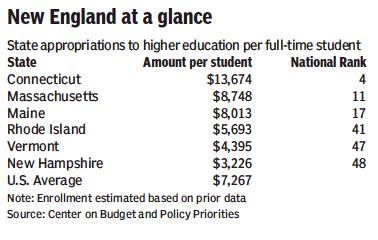HIGHER EDUCATION
Drop in spending stings RI colleges
State ranks 41st in public funding; tuition skyrockets, maintenance declines
By Linda Borg Journal Staff Writer
PROVIDENCE — Rhode Island ranked 41st in the nation on state spending per student in public higher education during the 2015-16 school year.
Among the six New England states, only Vermont and New Hampshire spent less on their public colleges, according to a report from the Center on Budget and Policy Priorities, a nonpartisan research institute in Washington, D.C.
The latest data also show that Rhode Island's support for higher education declined 23 percent from 2008 to 2016. By contrast, the national average dropped 15 percent.
Although Gov. Gina Raimondo's proposal to offer two years of taxpayer-funded college tuition would address some of those inequities, University of Rhode Island President David M. Dooley said it wouldn’t make up for two decades of decline in state support for public colleges.
“We haven’t caught up to where we were before the recession hit,” he said in an interview. “Since I’ve been president, our enrollment has grown significantly, yet we’ve added less than one staff position per year. We have one person who knows how to get a particular job done, and when they’re out, services are affected.”
Although voters have been very supportive of multimillion-dollar bonds for URI’s new engineering building and other capital projects, Dooley said the university has struggled to keep pace with routine maintenance on existing buildings. URI, at 4 million square feet, is the largest public acreage in the state.
Finally, Dooley said, URI has not been able to keep faculty salaries competitive with other large public research universities.
Tuition has been the biggest victim of chronic underfunding, Dooley said. In 2015, Rhode Island’s four-year public colleges were among the most expensive in the nation, according to the Rhode Island Public Expenditure Council.
In fiscal 2000, students attending URI paid 29 percent of the cost of tuition. Today, they pay 66 percent.
“The price we’ve paid is this,” Dooley said. “Our tuitions are much higher than states like North Carolina where they have much higher support for public education.”
While Raimondo’s college tuition plan can help make college more affordable, Dooley said it doesn’t address the systemic state funding issue.
“We’re working so hard to maintain affordability,” he said.
In-state tuition and fees at URI have jumped from $7,724 in fiscal 2007 to $12,884 in fiscal 2017, an average increase of 5.3 percent a year.
Rhode Island College tells a similar story. Tuition has nearly tripled since fiscal 2000.
More important, RIC has left critical financial positions unfilled, including the controller and vice president of administration and finance, sometimes for as long as 18 months.
According to a June 2016 state audit, “Vacancies and turnover in these positions have limited the oversight of financial transactions and contributed to the breakdown of internal controls.”
The audit also found that for the period under review, RIC didn’t have a documented policy for developing an annual budget.
Wages have been stagnant, according to Deborah Kaspin, president of the 400-member adjunct faculty union.
“Nobody who is working part time is making a living wage,” she said. “We analyzed how many hours we actually work a week. We figured we are being paid the same hourly rate as a nude model — $16 an hour.”
Building maintenance has also been neglected, administrators said. In Whipple Hall, where Kaspin teaches, the classroom floor sometimes swarms with insects.
RIC, however, is about to embark on a five-year plan to renovate its residence halls and classroom/lab spaces, according to Kristy dosReis, associate director for communications. The college is poised to reopen the newly renovated Gaige Hall and will start construction on its largest academic building this summer.
In a separate report, Rhode Island’s state funding for higher education has dropped almost 63 percent from 1980 to 2015 — the fifth largest reduction in the country, according to the State Higher Education Executive Officers Association.
“We’ve shortchanged our higher education system for a long time,” said Bill Fowles, chairman of the Council on Postsecondary Education. “In an ideal world, we would have additional resources at the school and student level.”
But, he said, we don’t live in an ideal world.
“The smartest way to get colleges back to this level,” Fowles said, “is to put it into the hands of students, not administration. It will have the greatest long-term effect on the K-12 system, and I think it will reduce student debt.”
Kevin Gallagher, the governor’s deputy chief of staff, said Raimondo recognizes the problem and is doing something about it.
Higher education investments have increased by nearly 20 percent over three years, including this year’s proposed higher education appropriation. This doesn’t include the nearly $20 million the state will spend this year on voter-approved higher education bonds.
Raimondo increased support to higher education by almost $17 million in fiscal 2016 and more than $8 million in fiscal 2017, he said. She is proposing an increase of $18 million in the coming fiscal year.
“We know we need to make these investments in order to increase opportunities for our students,” Gallagher said.
(401) 277-7823




